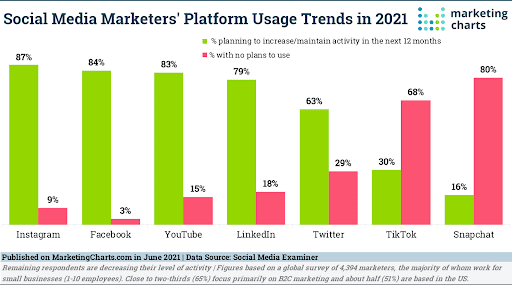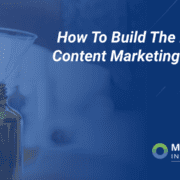The Super-Smart Guide to Content Optimization

Your content marketing efforts are one of the most important facets of your digital marketing strategy. Because you follow a distribution plan, your content is plastered everywhere.
This is great news! After all, the more platforms your content is shared on, the more chances it has to fall in front of prospective clients’ eyes. But believe it or not – not all content is created equal.
GrowthBadger.com defines content optimization as “the process of improving your content to get better results, like driving more traffic, users, leads or revenue.”
Basically, you have to optimize the content you are putting out so that it ranks higher on search engines.
Here’s a quick video from Teach Me Money Methods on the ins and outs of content optimization.
Quick Takeaways
- If you aren’t using content marketing, it’s time to get with it
- Maintaining a consistent and quality content marketing schedule with social media is crucial to your bottom line
- Content optimization determines how well you’re ranking in SEO
Why content optimization in the first place?
Content optimization can make or break the content you’ve worked so hard to make excellent. Without following the many rules of SEO, your content can get lost into the search engine void without a trace.
Obviously, this isn’t an acceptable outcome for your digital marketing efforts. By creating content that keeps what the search engines like to see in mind, you can give yourself (and your content) the best shot at hitting the top of the search results page.
How to optimize your content for SEO
Writing better content
Seeing how your organic search rankings are performing is crucial to a healthy content marketing strategy. Keywords drive your content, because the higher you rank with keywords, the higher you are on Google’s search results. Be honest, when was the last time you clicked the seventh link down?

Source: FinancesOnline
So what does better content look like? Well if you’re looking for blogging advice, we’ve got you covered with our guide to the perfect blog post. But for good measure, here’s some quick pointers for publishing content on your website.
Keep your word count between 1000 – 1800 words
Google likes articles within this range. Too little or too many might keep your hard work from ranking where it should!
Know your keywords
SEO/SEM is most successful when you know what words are the most important to what you talk about. Back to our tech example, words like tech, wearable, watch, would likely contribute best to a higher ranking among similar articles.
Have a compelling meta description
The hook is everything, right? Having a good description under your article title will be the blurb prospects read. If it’s boring or irrelevant to them, why would they click on your article?
Internal Links
Internal links are hyperlinks in your blog content that link to other pages within your domain. You should include 1-2 internal links in every blog post.
Call to Action (CTA)
CTAs tell readers what their next step is for interacting with your brand, and they can increase conversion rates by 121%. CTAs are the get up and do this part of your article, and are crucial to getting shares and engagement from your readers.
Include calls to action like starting a free trial, subscribing to an email list, or scheduling a free consultation. Don’t leave your readers hanging and give them something to do next.
Repurpose your content that performs well
Don’t forget about all that hard work you’ve already put into past content! Your best performing articles don’t need to sit on your website rotting to the webpages of time.
Articles that once brought in great traffic eventually fall out of touch with the ever changing world of search engine optimization. Not to mention, the actual content can become irrelevant to today’s world. This happens all the time in the ever-changing world of financial technology.
SocialMediaToday.com says:
Marketers can turn an article into a video, or an infographic – or the opposite in each case as well. They can reuse tips in an article by breaking them down into a series of posts or Stories frames, or they might post soundbites from a podcast directly to their social channels.
Having your writers restructure your content into different forms can be the gift that keeps on giving. Even a quick freshening up of an old article from a few years ago with modern information can be the makeover your content needs to be back on top of the page!
Optimize For Mobile
This seems like an obvious one, but when was the last time you opened your website on your phone? Mobile viewability is not only necessary but a must have when publishing content. More than half of all content is viewed on a phone.
If your website isn’t optimized for it, you’re only making yourself look bad! This is one of those things that is perfectly acceptable to hire contractors or consultancies for.
Paid content marketing
When all else fails, you can always cut the line! Google something. Anything. Chances are that the top 2 or 3 sites are promoted, or paid to be ranked that high. Companies in every industry often commit funds to put their sites above the competition.
Google ads sponsors their own form of an auction that you can bid on. Typically you’d bid on keywords that are relevant to your topic or business’ product or service.
The point? People like seeing their favorite social media stars showcasing products and their favorite companies. Lately companies like Hello Fresh and BetterHelp have seen record sign-up numbers with targeting paid advertising on successful podcast channels of diverse genres.
Paid social media promotion
How’s your social media presence? If your answer is we have none or not great, chances are your visibility is low. Being plugged into your target communities builds brand recognition and trust with prospects.
If your answer is pretty good, actually, paid social media promotion might be one of your best options when considering your paid content marketing strategy.
These companies have their own algorithms and targeting practices so that you know your advertisements are reaching your target audience and buyer personas. By paying your way in with your social media content you can gain followers and engagements on your posts to attract new customers.
Keep the content coming
Consistency is one of the most important things when considering your content marketing plan. You can follow all of the rules and still fall flat on your face if you aren’t building something your readers will come back to.
If your operation is expanding or you’re running out of time to properly handle your content marketing efforts, it might be time to hire some help!
There’s two options for this that yield similar results. You can either hire experienced content writers that have experience in SEO writing, or – hire a content marketing agency to do the research, writing, and publishing.
There’s benefits to both, but with a consultancy you often gain access to resources and experience you can’t always get with individual writers. Doing your research on both is important to finding what’s best for your business.
Don’t forget a distribution plan
Creating content is all well and good, but in the end means less if you aren’t sharing it everywhere you can. A good first step is a social media audit. Where is your company plugged in – more importantly, where do you and don’t you have a voice?
While targeted ads are good for short term engagement, online presence builds organic interaction on your content. With the open forum nature of social media, your customer base can leave comments on your articles and posts, boosting overall engagement.
Not to mention with the advent of viral content being timely by capitalizing on social media trends has never been more important. With an adaptable social media team that understands what’s in and what’s out, you can use whatever today’s trend is to promote your product.
How often should you be sharing your content?
Well, there’s a few factors to consider – like how frequently you’re publishing to your site and which platforms you’re posting on. We’re going to assume you’re pushing out articles daily.
With Twitter, you can share several times a day. Twitter timelines burn through much quicker than other platforms, so oversharing isn’t as easy to do as say, Instagram or Facebook.

Source: Marketing Charts
On more formal platforms like Facebook and Pinterest, once a day works just fine. Remember: the more time you put into cultivating an online community among your customers, the more views you will get on your articles.
You don’t just have to use social media! Content marketing automation has made it easy to send out newsletters across different platforms quickly and easily. Places like Mailchimp and Constant Contact can keep your reader lists organized, not to mention provide excellent metrics for analysis.
CruxFinder.com has a really awesome post about building a content calendar before a product launch that can help you out too.
How to measure your efforts from content optimization
Identifying KPIs:
What’s the point of putting in all this effort if you can’t tell what’s working? When creating your content marketing process, you have to define your key performance indicators (KPIs).
Examples of KPIs include:
- Measuring how a content marketing campaign impacts your sales team’s productivity
- Understanding the percentage of customers that were marketing-generated and what business was earned from content marketing
- Measuring hours of work put into content marketing vs money put into ad spending
KPIs are your benchmarks for success, and every other metric is what defines your KPIs.
Follower and engagement growth
An easy metric to check out the success of your social media is how many followers you are gaining and how many times your posts are being engaged with.
You can check out what posts lead directly to a prospect or customer clicking through to your profile and clicking the follow button to stay up-to-date with your company.
Followers aren’t everything though, engagement is! Engagement is any comment, like, or share that happens to one of your posts. Driving up engagement leads to social media platforms suggesting your content to their users.
Being on the front page of someone’s social media timeline is the golden goose of digital marketing. This is done through quality content appropriate to each platform and consistent monitoring of what is successful and what isn’t.
Conversion rate

Source: Disruptive Advertising
Views are great, but what happens after the initial click? Is the reader just leafing through your website? Are they sharing it? Are they actually purchasing your product and scheduling your services, or are they just browsing?
Conversion rate shows how many prospects are becoming customers. This metric is the real shining gem of your content marketing efforts! Converting prospects should be your number one goal with content marketing.
Oftentimes the places where you are producing and publishing media give you excellent analytics tools to help assess what ads or content is producing the best conversion rate.
By figuring out what content does the best across what platforms, you can make better, more informed decisions on what media to spend the most time on.
Value comparison between efforts
Deciding the best formula of what media to use and how much is the point of analyzing your digital marketing campaign. If your demographics tend to stay on LinkedIn over Twitter and the numbers prove it, put more time into your Twitter account.
This applies to the content you create as well. If your blogging efforts garner three times the attention as, say, your video testimonials, you need to focus your time and resources on your blog.
You can use A/B testing too to see which types of content are performing well on the platforms you distribute on.
Wrap up
Optimizing your content can be tricky even when you’re following the rules. SEO is changing all of the time and it’s important to stay up to date on your knowhow. By being on top of the current best practices, you can keep your content optimized to drive your site to the top of the results page.
Do you want to use some of the marketing strategies seen here on MIG’s site but need some help or advice? Marketing Insider Group has a team of 35+ experienced writers ready to produce content for YOUR business. Check out our weekly blog content service or schedule a free consultation.
The post The Super-Smart Guide to Content Optimization appeared first on Marketing Insider Group.












